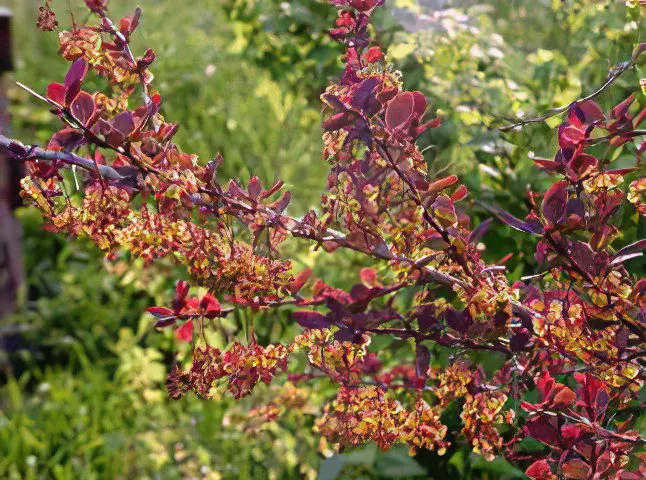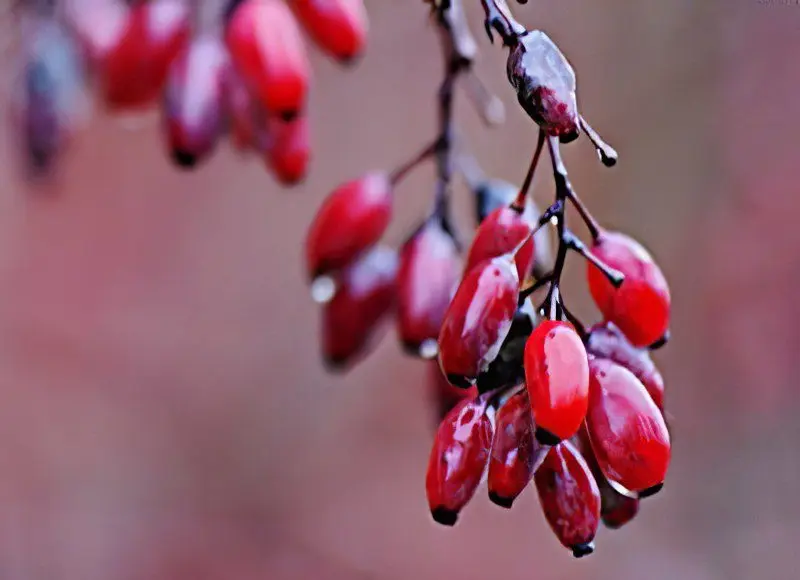Contents
Useful properties and use of decoctions and tinctures of barberry
Barberry Common
The common barberry is a prickly and deciduous shrub from the barberry family, the height of the plant does not exceed three meters. The shrub is highly branched and has a strong surface root system. The old branches of the plant have a gray bark, but the bark of the young branches is yellow-brown or yellowish-gray. The branches of the barberry are thin, sometimes with simple spines, and you can find a barberry bush with tripartite spines (there are buds in their axils).
Small branches appear from the buds, on which they have leaves. The leaves of the plant are oblong in shape, spiky cilia are located on the edges of the leaves. Barberry flowers emit a strong aroma, the color of the flowers is light yellow. Flowers in the amount of 15–25 are collected in drooping axillary racemes.

The fruit of the barberry is a dark red berry. The berry is very juicy, has several seeds. The weight of the barberry fruit does not exceed 4 grams. The seeds are dark brown in color, have a flattened shape, small wrinkles.
The flowering of barberry begins in May and lasts until June. Fruit ripening occurs from July to October.
Since ancient times, in Babylon and the countries of India, barberry has been used as a medicine.
Useful properties of barberry
The fruits, leaves, roots and bark of the barberry are parts of the plant used to make medicines.
The barberry contains the substance berberine, due to which the drugs from this plant have a choleretic effect.
The roots of the plant contain various alkaloids, carotene, tannins, vitamin C, vitamin E and organic acids. Therefore, a decoction of the root is used as a rinse and lotion for various diseases.
Barberry has an anti-inflammatory, diuretic, astringent, antimicrobial effect, and also stops various bleeding.
Preparations prepared on the basis of barberry are used for the following diseases: – diseases of the liver; – stomach ulcer; – duodenal ulcer; -tuberculosis; – bleeding of the uterus; – inflammation of the upper respiratory tract; – morphinism; – tumors in various organs.
barberry care

After planting the plant, mulching should be done immediately. When a year has passed since planting the plant, you need to start fertilizing the soil. In the spring, you need to make nitrogen fertilizers. In the future, once for three to four years, fertilizing is done. In addition to nitrogen, complex fertilizers must be applied, for example, the Kemira universal fertilizer.
Barberry should be watered once every 7 days. The plant needs regular loosening and weeding. When underdeveloped and weak shoots appear, they are cut off. In the spring, you need to clean the stems of old shrubs (weak and thin should be cut off).
If the barberry was planted as a hedge, then in the second year after planting, pruning should be done: 50–70% of the above-ground part of the plant is cut off. In subsequent years, pruning is done twice a year, namely the first time – in early June and the second time – in early August. Barberries of low height do not need a haircut, so they are very often used to divide a garden plot into separate zones.
Reproduction of common barberry
Barberry propagates by root offspring, seeds, summer cuttings and division of bushes.
Reproduction by seeds. As soon as the fruits are harvested, they must be squeezed out, then passed through a sieve, washed and dried a little. After all these operations have been completed, seeds can be sown in grooves, the depth of which is 1 cm. The best time for sowing seeds is autumn. If you decide to sow the seeds in the spring, then before sowing they need to be stratified for two to five months in a room with a temperature of 2-5 ° C. Almost all seeds will sprout, only 5% of the sowing may not sprout. The land on which the seeds were sown must be fertile and loose. As soon as the first two true leaves appear, the seedlings must be thinned out. The distance between the left seedlings should be at least 30 mm. Within two years, it is better to grow seedlings without transplanting them to another place.
Reproduction by cuttings. With this method, you need to cut off the semi-woody branches of the year of planting and plant them. Next, the cuttings are cut, the length of each should be no more than 10 cm. The cut should be done so that it is 2–3 cm from the lower node to the cut, all leaves should be cut off.
The cuttings are rooted in a small greenhouse or in a box in which there is no bottom. The soil is prepared in advance. 50% of the soil should consist of sand, and sand should be poured over the soil, the layer of which should be 2-3 cm (this layer of sand should be mixed with charcoal).
Further, at a depth of 1–2 cm, the cuttings are planted in the soil. The ends of the cuttings should be in contact only with a layer of sand. On top of the greenhouse or on the box, you need to lay a film or install glass – this is necessary so that high humidity is maintained in the place for grafting.
Barberry treatment

In folk medicine, barberry preparations are very often used in the presence of internal bleeding, in the postpartum period, and also in diabetes. And a couple of years ago, another effect of barberry preparations was revealed: the plant enlarges the spleen in people with malaria (malarial plasmodia are expelled into the blood by berberine).
All parts of the plant contain alkaloids, the most important of which is given to berberine. This substance lowers blood pressure, calms, reduces the frequency of heart contractions. Berberine and barberry tincture on alcohol are used for cholecystitis, gallstone disease and chronic hepatitis (berberine drives bile out of the body).
Barberry Recipes
Tincture to stop uterine bleeding. Take 20 grams of dry barberry leaves and pour 50 ml of alcohol (70%). The composition is infused for about two weeks in a warm room. The tincture will be ready for use when it is dark yellow in color. And the taste of the tincture should be slightly sour.
A decoction of barberry leaves. To prepare it, you need to take 15-20 grams of dry chopped barberry leaves, add 200 ml of water and put on fire, bring to a boil. Next, simmer for 15 minutes on low heat, remove from heat and insist for 40 minutes, filter and dilute with boiled water until the volume reaches the original. This decoction is taken 3 times daily, 1 tablespoon. This decoction helps with peptic ulcers and nausea.
A decoction of barberry fruits. It is necessary to take 30-40 grams of crushed fruits of the plant and pour them with one glass of water. Boil this composition should be about half an hour. After boiling, strain the product and dilute with boiling water to the original volume. Such a decoction should be taken 3 times a day before meals, 50 ml or half a glass. It is used as a choleretic and antipyretic agent.
A decoction of barberry roots for hepatitis. To prepare this decoction, you need to take half a teaspoon of dry chopped roots and pour one glass of water, then put on fire and boil for half an hour, and then strain and cool. Further, like other infusions and decoctions, the product should be diluted with water until the initial volume is obtained. You need to drink such a decoction every day 3 times, a single dose of admission is 1 teaspoon. The same decoction can be taken with pleurisy or bronchitis.
Tincture of barberry leaves. Take 20 grams of barberry leaves and pour half a glass of 40% alcohol (vodka is also suitable). Leave to infuse for 14 days. After that, the contents must be squeezed and filtered. Take this tincture three times a day, 25-30 drops at a time. The course of treatment is 14-20 days. You need to store this tincture in a dark jar and a dark place. Tincture helps with diseases of the kidneys, liver, hepatitis and cholelithiasis.
Contraindications to the use of barberry
Preparations from barberry should not be taken for bleeding if the placenta is not completely separated from the uterine walls in a sick woman.
During pregnancy, barberry is contraindicated.
Green berries of barberry should not be consumed at all, as they contain poison.









